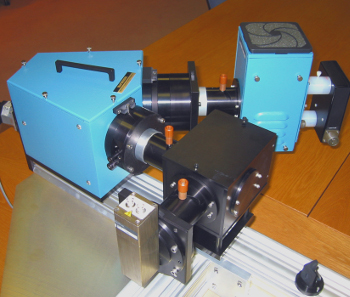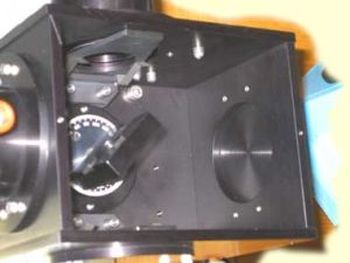
Spectral Work Station Multimode Spectrometer
McPherson introduces a multi mode, transmssion, fluorescence, Raman, microscopy spectrometer as another powerful tool for both research and education. It's basic setup exemplifies both the complexity and the fundamentals of spectroscopy. The system was designed with single beam, f/2 optics to provide optimal energy throughput. The unit is capable of many spectroscopic functions and its compact size (approximately 3 x 4 feet on an optical table) proves ideal for any laboratory setup.
The monochromator component of this system is the Model 272 200mm f/2 instrument. Bilaterally adjustable slit assemblies (vary frm 10microns to 4mm) allow variable bandpass and resolution for measurments. This monochromator was utilized for its throughput; however, the system could be configured including a variety of McPherson higher resolution monochromators like the 350mm 2035.
| Optical Design | Czerny Turner design Monochromator / Spectrometer |
| Focal Length | 350 mm |
| Aperture Ratio | f/4.8 (NA 0.1) |
| Wavelength Range | refer to grating of interest for range |
| Wavelength Accuracy | ±0.2 nm |
| Wavelength Reproducibility | ± 0.05 nm (with 1200 G/mm grating) |
| Grating Size | 68 x 68 mm (single grating holder, optional dual-grating turret) |
| Slits | Micrometer adjustable width 0.01 to 4 mm, height settings from 2 to 20 mm |
| Slit Locations | Axial and lateral, with optional port selection mirrors |
| Focal Plane | 25-mm, multiply dispersion by the width of your detector for range |
| Grating Groove Density (g/mm) | 3600 | 2400 | 1800 | 1200 | 600 | 300 | 150 | 75 | 50 |
| Spectral Resolution at 312.6nm (nm, FWHM) | 0.02 | 0.025 | 0.035 | 0.05 | 0.1 | 0.2 | 0.4 | 0.8 | 1.2 |
| Reciprocal Linear Dispersion (nm/mm) | 0.7 | 1 | 1.5 | 2 | 4 | 8 | 16 | 32 | 48 |
| Wavelength Range from 185nm to | 430 | 650 | 865 | 1.3 um | 2.6 um | 5.2 um | 10.4 um | 20.8 um | 31.2 um |
| First Order Littrow Blaze (nm) | 240 | 240 | 180 | 200 | 250 | 280 | 300 | 2 um | 600 |
| holo | 300 | 250 | 300 | 300 | 300 | 500 | 3 um | 12 um | |
| holo | 400 | 400 | 500 | 500 | 800 | 8 um | 14 um | ||
| holo | 500 | 750 | 750 | 1.25 um | 10 um | ||||
| 750 | 1 um | 1 um | 2.5 um | 12 um | |||||
| 1 um | 1.8 um | 3 um | 4 um | ||||||
| holo | holo | 4 um | 6 um | ||||||
| 8 um | |||||||||
